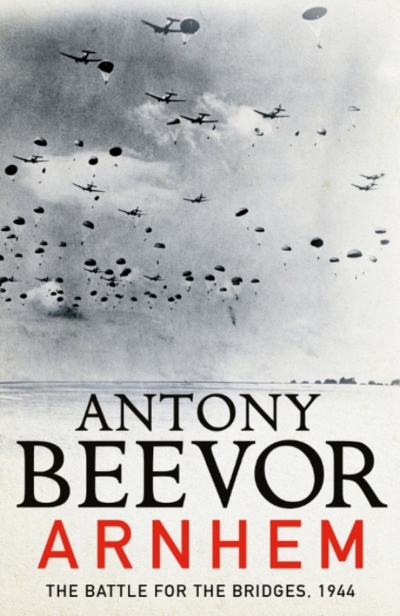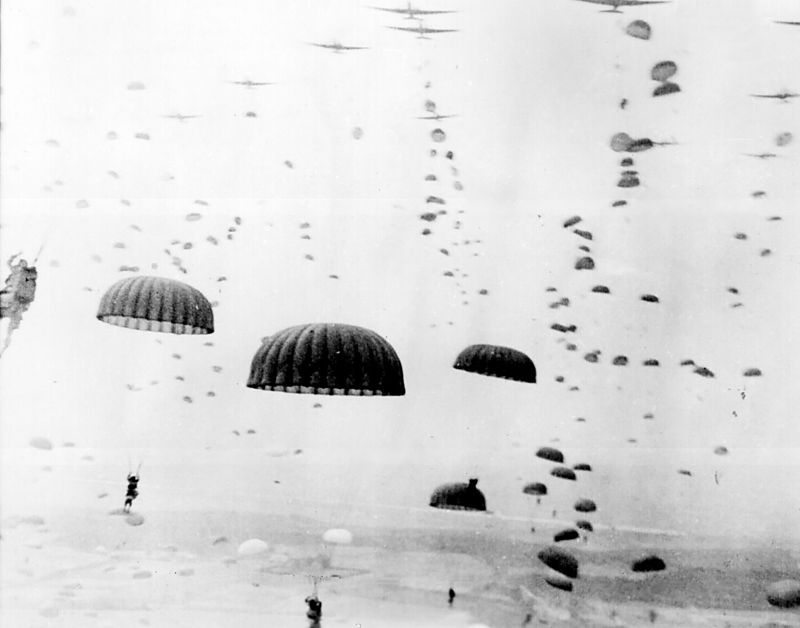| Title: | Arnhem - The Last German Victory |
| Writer: | Beevor, A. |
| Published: | Penguin UK |
| Published in: | 2018 |
| Pages: | 560 |
| Language: | English |
| ISBN: | 9780241326763 |
| Description: |
"Saturday, September 2. Instructed to land southeast of Kortrijk to stop the retreat of the Kraut on the other side of the Scheldt. Cancelled due to storm. Frigging storm! Sunday 3 September. Instructed to land near Maastricht. Operation cancelled because American armour units are advancing too fast. Bloody Americans," wrote Major J.E. Blackwood of the 11th Battalion, 4th Brigade. He and the other members of the 1st British Airborne Division were frustrated in their barracks in September 1944. They were still not operational. This changed when they were dropped from 17 September, as part of operation Market Garden near Arnhem to conquer the bridges over the Rhine. What followed grew into one of the most famous battles of the Second World War. Bookcases have been written about it and many films have been made about it, such as "A Bridge Too Far". In "The Battle of Arnhem" from 2018, the famous British historian Antony Beevor gives his vision on the fights. Antony Beevor is one of the best-known, perhaps the best-known author about the Second World War of our time. He was trained at the British Military Academy in Sandhurst and served in the British Army for five years. He has written widely read works; among other things on The Battle of Stalingrad (Stalingrad by Antony Beevor), the landings in Normandy (D-Day by Antony Beevor) and the Ardennes Offensive (The Ardennes Offensive by Antony Beevor). As is the case with well-known historians, Beevor's work is not free of criticism. Critics point out that there are sometimes minor historical imperfections in his books. This latest book also contains a number of inaccuracies. He writes that in June 1942, when the arrests of Jews were at their peak in the Netherlands, strikes and protests broke out. It is true that the February strike arose as a reaction to the arrest of a number of Amsterdam Jews, but this was in February 1941 and afterwards there was never a large-scale protest in our country against the persecution of the Jews. A few years ago, Historic Newspapers described Beevor as a novelist. And he certainly is. This explains why his books are always so pleasant to read. Beevor has an easy and accessible style of writing and quotes a lot from testimonials. This allows you to better empathize with the experiences of people during the fighting. He also knows how to tell stories that at first glance are less exciting, such as briefings, in a captivating way. "The Battle of Arnhem" contains many passages that would not be out of place in a war novel or a film script. There are examples of superhuman heroism and self-sacrifice, but also of incompetence and pure evil. As was mentioned above, much has been written about Operation Market Garden. It is therefore difficult to really come up with new insights. Beevor does not do this, despite the announcement on the back cover. The fact that the operation was abruptly planned and that there was a large degree of overestimation on our side and underestimation of the enemy, has already been demonstrated by previous authors. This underestimation of the attack is aptly illustrated, among other things, by one of the participating British paratroopers taking a dartboard for the dropping, "to get through the boring evenings." While other authors sometimes argue that Market Garden could have succeeded if a few elements had gone differently, Beevor characterizes it as "a very bad plan from the outset and from the top." Field Marshall Bernard Montgomery in particular gets a reprimand from him. This showed no interest in the practical problems associated with airborne operations. For example, he was insufficiently informed about the terrain and the strength of the enemy, while many Dutchmen, including Prince Bernhard and several officers of the Princes Irene Brigade, warned him that the terrain was not suitable for tanks. The Dutch resistance had also informed him that there were strong German formations in the area of operations. Beevor also doubts whether Lieutenant General Brian Horrocks, commander of the XXX Corps that had to advance from Belgium, in the context of a ground operation, to secure the bridges over the Waal and Rhine, was fit for his task. The man was badly injured in 1943 and still struggled with the consequences. Horrocks, for example, according to Beevor, failed to anticipate the conquest of the bridge at Nijmegen by keeping troops in reserve, so that this success could not be exploited in time. He also fully blamed others for the failure of the operation, without taking responsibility. The author describes in detail all aspects of Market Garden, from the landings on 17 September, to the evacuation of the troops from Oosterbeek on the 25th of that month. This is in contrast to other books published recently, which often focus on a specific part of the battle (a unit or a sector). In fact, the attack failed in the first few days. For example, the bridge in Nijmegen should have been conquered on 17 September. This did not happen until 20 September 1944. Many times Beevor comes out critically. This is how he calls it incredible that Brigadier Norman Gwatkin ordered the Irish Guards to stop at Valkenswaard on 17 September instead of pushing on to Eindhoven. This caused unnecessary delay, which confused the schedule. However, he also praises the participating soldiers for their courageous action. As a result of the fighting, several Victoria Crosses were awarded, the highest British military award. He also shows empathy for the Dutch people who first suffered heavily from the battle and then had to contend with the Hunger Winter. Another sad fate to which he pays attention is that of the 1st (Polish) Independent Parachute Brigade and especially their commander Stanislaw Sosabowski, who was transferred after the operation. The British accused the Poles of having fought badly and of insubordination. This while the soldiers of the 1st (Polish) Independent Parachute Brigade fiercely fought to create a connection to the troops in Oosterbeek. The insubordination only consisted of Sosabowski having warned a number of times about the dangers associated with the British operation plans and command. Moreover, it turned out later that he was absolutely right with his criticism. The author highlights the battleground from both sides. The Germans, under the command of Generalfeldmarschall Walter Model, managed to quickly gain reinforcements from Germany and they threw everything they could in the battle, including the Ersatzbataljon under Major Hans-Peter Knaust, which consisted of persons who missed a limb. The commander himself was walking on crutches, because he had lost his leg near Moscow. This battalion would distinguish itself positively in the battle. The paratroopers near Arnhem and Oosterbeek were soon forced into the defensive. All attempts to support the British unit that occupied the northern access route to the bridge in Arnhem proved fruitless because of the German resistance. The other British units were soon forced into the defensive in and around Oosterbeek, where they soon had to contend with a lack of ammunition and food. The failure of the radios and the struggles over leadership were not conducive either. According to many participating men, the battle around Arnhem and Oosterbeek consisted of the fiercest battles they had ever experienced. They fought with rifles, grenades and bazooka’s, but also with boots, fists and knives. Beevor tells the story of the heroic conquest of the bridge in Nijmegen by the Americans and the tough battle in Arnhem and for Hells Highway. He knows how to incorporate the experiences of ordinary soldiers and officers into the book in a proper manner. In this way he paints a complete and comprehensive picture that covers all aspects of the struggle, including the situation of civilians and the care of the wounded. Because the story is brimmed with anecdotes and personal testimonials, the book is very easy to read. Occasionally there is a touch of humor. He writes, for example, about the military experiences of a unit that consisted of ground staff of the Luftwaffe, which was limited to the rolling of petrol drums. For the rest, however, there is little reason to laugh. The book contains gruesome details about the battle, for example, a story about an American officer who was hit by light rail grenades and who, because of the excruciating pain it caused, begged his own men to shoot him. After the allied troops had been evacuated at Arnhem, the Germans took revenge on the Dutch population, partly because of the railway strike. The food supply to the large cities was stopped, resulting in a famine. Beevor also devotes extensive attention to this episode, which was to become known as the Hunger Winter. "The Battle of Arnhem" provides a good overview of the entire Market Garden operation. The title is therefore perhaps less well chosen. The book is by no means limited to just the battle in Arnhem. A minor drawback is also that the translation occasionally rattles, but this is generally not disturbing. It remains to be seen whether this is a new standard work. Much has been written about this subject and these books are certainly still relevant. "The Battle of Arnhem", as mentioned earlier, does not provide new insights into the struggle. It does offer a good and accessible overview of operation Market Garden and all related aspects. In the context of the 75-year commemoration, it is definitely recommended to read. |
| Rating: |     (Very good) (Very good) |
Information
- Translated by:
- Fernando Lynch
- Article by:
- Wesley Dankers
- Published on:
- 20-04-2019
- Last edit on:
- 22-04-2019
- Feedback?
- Send it!




